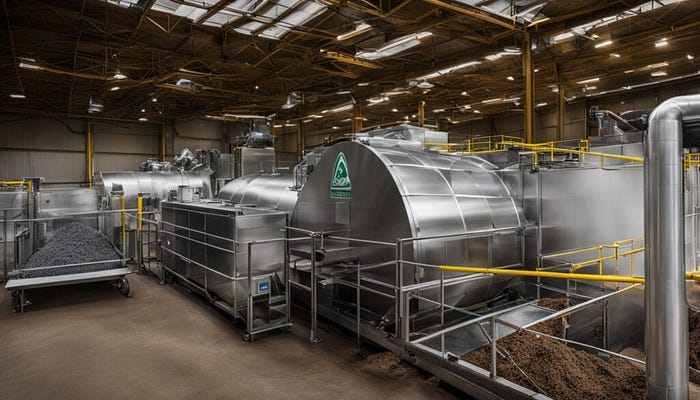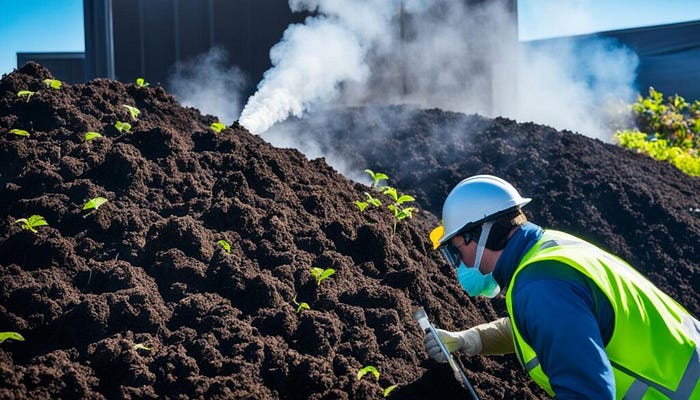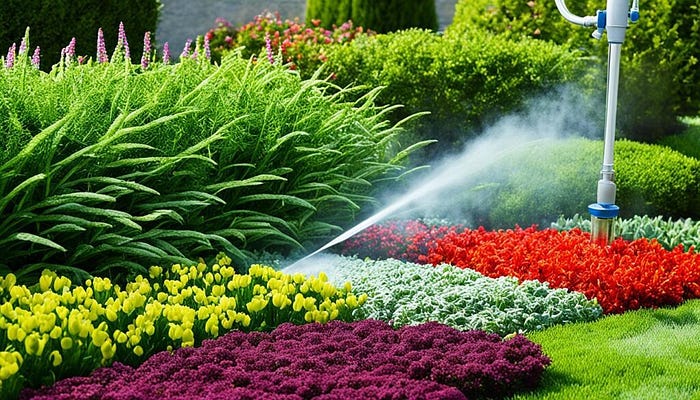
Are you worried about the risks of using untreated compost in your garden? Making sure your compost is sterilized is crucial for a healthy garden. We’ll share 7 key tips to sterilize compost safely. This ensures your compost is clean from harmful pathogens, weed seeds, and other bad stuff.
Understanding the Importance of Sterilizing Compost
Sterilizing compost is key to keeping your garden healthy. It gets rid of harmful pathogens and weed seeds. This makes a safe soil amendment that helps plants grow strong and produce well.
Benefits of Sterilized Compost
Using sterilized compost has many benefits. It makes the soil better and richer, fights plant diseases, and stops weeds. This kind of compost is great for your plants, making them healthier and more productive.
Risks of Using Untreated Compost
Untreated compost can bring pests, diseases, and weeds to your garden. It might have harmful germs like E. coli and salmonella, which are bad for plants and people. Also, it can spread weeds that are hard to get rid of. So, it’s important to sterilize compost to keep your garden safe and healthy.
“Healthy compost-rich soil with beneficial microbes protects plants from pathogen invasion. Research shows that plants recruit protective microbes when under stress or attack to improve immunity.”
Methods for Sterilizing Compost
Creating healthy, nutrient-rich compost is key. There are two main ways to do this: heat treatment and chemical treatment. Let’s look at each method closely.
Heat Treatment
Heat is the best way to kill harmful stuff in compost. Keep your compost piles over 140°F (60°C) for a few days. This kills bad pathogens and weed seeds. This process, called thermophilic composting, needs careful watching to work right.
Getting the heat right is important. Temperatures over 130°F (54°C) kill most bad fungi and bacteria but keep good microbes. It’s also key to have the right mix of materials, like 4 parts carbon-rich to 1 part nitrogen-rich.
Chemical Treatment
Chemicals can also sterilize compost, but it’s not as common. Stuff like chlorine, hydrogen peroxide, or ammonia can kill pathogens and weed seeds. But, using chemicals needs extra safety steps to protect the environment and plants.
Chemical sterilization has good and bad sides. It can stop pests and diseases. But, it can also kill good microbes that help plants and make compost less effective. So, think about what you need before choosing a method.

Choosing to sterilize your compost depends on knowing the process well. Pick the right method and follow best practices. This way, you get safe, effective compost that feeds your garden and helps plants grow strong.
Preparing Your Compost for Sterilization
Before you start sterilizing compost, make sure it’s ready. This means shredding big pieces, keeping the right moisture, and managing the composting well.
Shredding big items like wood or bulky stuff makes the compost uniform. This makes sure heat or chemicals spread evenly, killing off pathogens and seeds.
- Keeping the compost moist, between 40–60%, is key. It keeps microbes working well and heat building up.
- Turning or aerating the compost keeps it aerobic and speeds up breaking down. This makes the compost even and easier to sterilize.
Getting your compost ready for sterilization is crucial. It helps heat or chemicals work better, killing off bad stuff.
By doing these steps, your compost will be ready for sterilization. This makes sure your growing medium is healthy and free of pathogens.

Heat Treatment: The Most Effective Method
Heat treatment, or thermophilic composting, is the top way to sterilize compost. To make a hot composting system work, the pile should be big, at least 3 cubic yards. It should have layers of green and brown materials to help it heat up.
Setting Up a Hot Composting System
It’s key to keep an eye on the temperature in your compost pile. Use a thermometer to check it daily, aiming for 140–160°F (60–71°C) for 3 days straight. If the temperature drops, turn the pile or add more materials to heat it up again. This keeps all pathogens and weed seeds gone.

Monitoring and Maintaining Temperatures
Make sure to turn and check your compost pile often to hit the 140°F (60°C) mark. Heating moist soil to 145°F (63°C) for 30 minutes kills many harmful organisms. At 160°F (71°C) for 30 minutes, it gets rid of more bacteria and insects. To kill weed seeds, heat the soil to 180°F (82°C) for 30 minutes.
Heat of 212°F (100°C) gets rid of tough viruses and seeds.
“Consistent temperature monitoring is crucial for successful heat treatment of compost.”
To keep the pile hot, you might need to turn it or add more materials. Turning the soil helps heat it evenly and gets it hotter faster. Building a special device for your needs can be the best way to treat soil.
Sterilize Compost: Eliminating Pathogens and Weed Seeds
Composting turns organic waste into a soil amendment full of nutrients for your garden. But, untreated compost might have harmful pathogens like E. coli and salmonella, and weed seeds. To make sure your compost is safe and works well, you must sterilize it first.
Compost sterilization aims to eliminate pathogens and destroy weed seeds. By heating it to 140°F (60°C) or more for a long time, you can kill these unwanted contaminants. This makes your compost safe and free from pathogens, ready for your garden.
Managing your compost pile right is key to getting the right temperature and moisture. The mix should have a carbon-to-nitrogen (C: N) ratio of 25:1 to 40:1 for good compost. It should also be moist, around 40% to 60% by weight. Plus, it needs oxygen of 5% or more and a pH of 6 to 8 for efficient breakdown.

By following these steps, you can make sure your compost is pathogen-free and weed-free. This gives you a safe, nutrient-rich soil amendment for your garden.
Chemical Treatments: Pros and Cons
Heat treatment is often the top choice for sterilizing compost. But, chemical treatments can also work well. Chemicals like chlorine, hydrogen peroxide, and ammonia-based products can kill pathogens and weed seeds. Yet, they need careful handling and safety steps to avoid harm to people and the planet.
Common Chemical Sterilants
Chlorine, hydrogen peroxide, and ammonia-based products are key chemical sterilants for compost. They can kill off bad microorganisms and weed seeds, making compost safer for gardens. But, knowing the good and bad of each chemical is key for safe and effective composting.
Safety Precautions for Chemical Treatment
When using chemical sterilants in composting, safety first is a must. This means wearing gloves and goggles, ensuring good airflow, and safely getting rid of any chemicals. Following the product’s directions and local laws is vital to keep everyone and the planet safe.
Chemical treatments can be a good way to sterilize compost, but think about the risks and benefits. Taking safety steps and following best practices lets you use chemicals wisely and get the compost you want.

“Careful handling and strict safety protocols are essential when using chemical sterilants for compost to minimize environmental and health risks.”








Paxlovid buy online: paxlovid price – paxlovid buy
rybelsus generic https://rybelsus.tech/# cheap Rybelsus 14 mg
Buy semaglutide
El fichaje de Ronaldo por Al Nassr fue un momento clave en su carrera | Los debates sobre el equipo ideal para CR7 nunca terminan https://cristiano-ronaldo.com.mx | La decision de Ronaldo de jugar en Arabia Saudita genero gran expectacion | La camiseta de CR7 con el numero 7 es un icono mundial | Los videos motivacionales de CR7 son populares en redes sociales El retiro de Cristiano Ronaldo.
1win in Egypt provides high-quality casino games and excellent services | The games available at the 1win casino attract entertainment and thrill seekers 1win Egypt | The online casino 1win is considered the best in the Egyptian market | The official 1win site provides many options for sports betting | You can now register on 1win easily online 1win games.